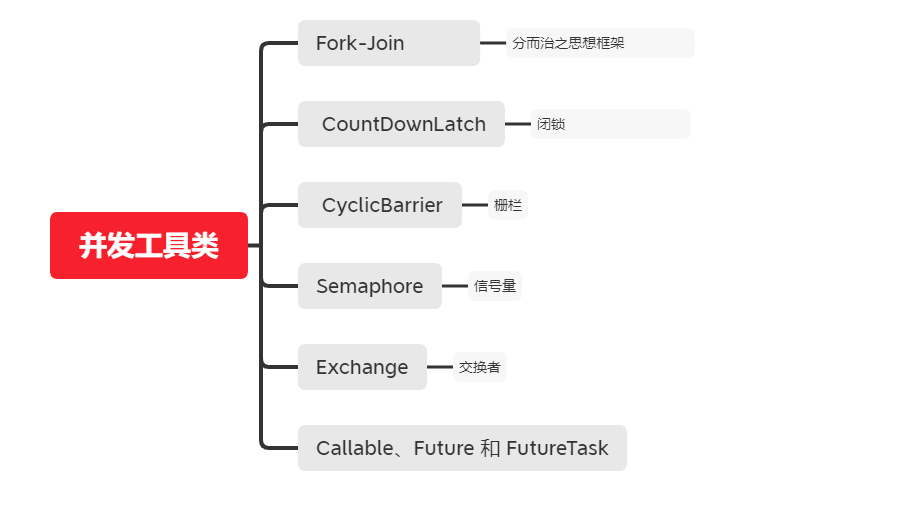
4、Semaphore 信号量
Semaphore 是用来控制同时访问特定资源的线程数量的,可以协调各个线程保证合理的使用公共资源。从以下代码可以看的出来Semaphore 可以作流量控制,其构造方法Semaphore(int permits)用于表示许可证(流量大小)数量。
import java.util.concurrent.Semaphore;
/**
* Semaphore 信号量演示类
* @author ckj
*
*/
public class SemaphoreTest {
static Semaphore semaphore = new Semaphore(1);
/* acquire():获取许可证
* release():归还许可证
* intavailablePermits():返回此信号量中当前可用的许可证数。
* intgetQueueLength():返回正在等待获取许可证的线程数。
* booleanhasQueuedThreads():是否有线程正在等待获取许可证
* void reducePermit(s int reduction):减少 reduction 个许可证,是个 protected方法。
* Collection getQueuedThreads():返回所有等待获取许可证的线程集合,是个 protected 方法
*/
public static void main(String[] args) throws InterruptedException {
// 当前Semaphore 令牌为1个
// 通过acquire方法获取了1个令牌,当前令牌为0;
semaphore.acquire();
System.out.println("可用令牌数:" + semaphore.availablePermits());
// 令牌为0 通过acquire 获取的话 会被阻塞
semaphore.acquire();
System.out.println("可用令牌数:" + semaphore.availablePermits());
// 通过release方法归还1个令牌,当前令牌为1;
semaphore.release();
System.out.println("可用令牌数:" + semaphore.availablePermits());
}
}下面使用Semaphore 实现一个数据库连接池,在前面的文章中使用wait/notity 实现过一次。
import java.util.LinkedList;
import java.util.concurrent.Semaphore;
/**
* 使用Semaphore实现一个简单的数据库连接池
*
* @author ckj
*
*/
public class DbPool {
/* 定义一个容器用做数据库连接池,由于数据库连接多做获取与释放操作所有选用LinkedList,池化技术与队列技术会在后续章节演示 */
public LinkedList<Connection> connectionPool = new LinkedList<Connection>();
private Semaphore semaphore ;
public DbPool(int poolSize) {
if (poolSize > 0) {
for (int i = 0; i < poolSize; i++) {
connectionPool.addLast( new Connection());
}
semaphore = new Semaphore(poolSize);
}
}
/* 归还连接,使用完连接后将连接重新放入池中 */
public void reConnection(Connection connection) {
if (connection != null) {
synchronized (connectionPool) {
// 将连接放到最后
connectionPool.addLast(connection);
}
//不放在同步块里面,保证同步块颗粒度
semaphore.release();
}
}
/**
*由于acquire() 没有设置超时时间,设置超时时间的参数就不需要了
*
*
* @throws InterruptedException
*/
public Connection getConnection() throws InterruptedException {
semaphore.acquire();
Connection connection =null;
synchronized (connectionPool) {
connection = connectionPool.removeFirst();
}
return connection;
}
class Connection {
}
}
测试代码依然使用前面文章使用过的测试类,稍微做了修改
import java.util.Random;
import java.util.concurrent.CountDownLatch;
import java.util.concurrent.atomic.AtomicInteger;
import com.ckj.concurrent.tools.DbPool.Connection;
/**
* 1、初始化线程池大小 2、模拟多线程测试拿取线程池
*
* @author ckj
*
*/
public class DbPoolTest {
static DbPool pool = new DbPool(10);
static CountDownLatch latch; // 并发工具类,闭锁,模拟多线程并发测试
static class PoolTest implements Runnable {
int count;
AtomicInteger success;
AtomicInteger error;
public PoolTest(int count, AtomicInteger success, AtomicInteger error) {
this.count = count;
this.success = success;
this.error = error;
}
public void run() {
while (count > 0) {
try {
long start = System.currentTimeMillis();
// 获取线程池
Connection connection = pool.getConnection();
if (connection != null) {
System.out.println("Thread_"+Thread.currentThread().getId()
+"_获取数据库连接共耗时【"+(System.currentTimeMillis()-start)+"】ms.");
try {
Random r = new Random();//让每个线程持有连接的时间不
// 模拟业务代码执行
Thread.sleep(100+r.nextInt(100));
} finally {
// TODO: handle finally clause
pool.reConnection(connection);
success.incrementAndGet();
}
} else {
error.incrementAndGet();
System.out.println(Thread.currentThread().getName() + "等待超时!");
}
} catch (Exception e) {
} finally {
count--;
}
}
latch.countDown(); // 执行闭锁
}
}
public static void main(String[] args) throws InterruptedException {
latch = new CountDownLatch(50);
AtomicInteger success = new AtomicInteger();// 原子类计数器:统计可以拿到连接的线程(后续会介绍到)
AtomicInteger error = new AtomicInteger();// 原子类计数器:统计没有拿到连接的线程(后续会介绍到)
for (int i = 0; i < 50; i++) {
Thread thread = new Thread(new PoolTest(20, success, error));
thread.start();
}
latch.await();
System.out.println("总共尝试了: " + (50 * 20));
System.out.println("拿到连接的次数: " + success);
System.out.println("没能连接的次数: " + error);
}
}
稍微改造下让他变得更像线程池,添加可用跟已用线程池
import java.util.LinkedList;
import java.util.concurrent.Semaphore;
/**
* 使用Semaphore实现一个简单的数据库连接池
*
* @author ckj
*
*/
public class DbPool {
/* 定义一个容器用做数据库连接池,由于数据库连接多做获取与释放操作所有选用LinkedList,池化技术与队列技术会在后续章节演示 */
public LinkedList<Connection> connectionPool = new LinkedList<Connection>();
// 可用连接 和 已用连接
private Semaphore semaphoreful, semaphoreless;
public DbPool(int poolSize) {
if (poolSize > 0) {
for (int i = 0; i < poolSize; i++) {
connectionPool.addLast(new Connection());
}
semaphoreful = new Semaphore(poolSize);
semaphoreless = new Semaphore(0);
}
}
/* 归还连接,使用完连接后将连接重新放入池中 */
public void reConnection(Connection connection) throws InterruptedException {
if (connection != null) {
semaphoreless.acquire();
System.out.println("当前有" + semaphoreful.getQueueLength() + "个线程等待数据库连接!!" + "可用连接数:"
+ semaphoreful.availablePermits());
synchronized (connectionPool) {
// 将连接放到最后
connectionPool.addLast(connection);
}
// 不放在同步块里面,保证同步块颗粒度,增加semaphoreless.acquire() 阻塞
semaphoreful.release();
}
}
/**
* 由于acquire() 没有设置超时时间,设置超时时间的参数就不需要了
*
*
* @throws InterruptedException
*/
public Connection getConnection() throws InterruptedException {
semaphoreful.acquire();
Connection connection = null;
synchronized (connectionPool) {
connection = connectionPool.removeFirst();
}
semaphoreless.release();
return connection;
}
class Connection {
}
}
最近网上看到一个面试题,说有三个线程t1,t2,t3 如何保证按顺序执行。我们想到的是使用join 方法。其实如果用Semaphore 一样可以实现
import java.util.concurrent.Semaphore;
public class SemaphoreSort {
static Semaphore semaphore = new Semaphore(1);
static class T1 extends Thread{
public void run() {
System.out.println("执行t1");
semaphore.release();
}
}
static class T2 extends Thread{
public void run() {
try {
Thread.sleep(10);
} catch (InterruptedException e) {
// TODO Auto-generated catch block
e.printStackTrace();
}
System.out.println("执行t2");
semaphore.release();
}
}
static class T3 extends Thread{
public void run() {
System.out.println("执行t3");
semaphore.release();
}
}
public static void main(String[] args) throws InterruptedException {
semaphore.acquire();
new T1().start();
semaphore.acquire();
new T2().start();
semaphore.acquire();
new T3().start();
}
}
解法多种多样,随手写了一个,不要嫌弃!





















 1311
1311











 被折叠的 条评论
为什么被折叠?
被折叠的 条评论
为什么被折叠?








